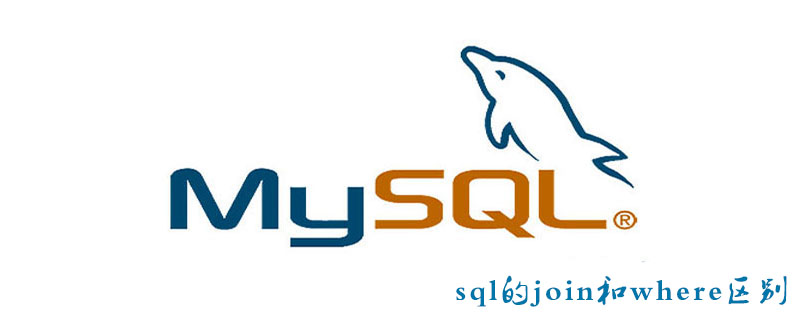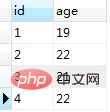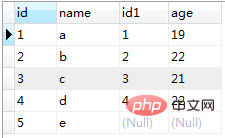The difference between join and where in sql
The function of the join keyword is to join multiple tables according to certain conditions, so that data can be obtained from multiple tables.
Recommended courses: MySQL Tutorial.

The on condition and where condition can be followed by join. Here I mainly talk about the difference between the two
Create two simple tables for testing and add data, as shown below, one table is named id_name, the other is named id_age


First look at the result without adding conditions - t2.age ='22'
SELECT * from id_name t1 LEFT JOIN id_age t2 on t1.id = t2.id
Get

1. Take left join as an example here. First run where and add the condition - when t2.age ='22'
SELECT * from id_name t1 LEFT JOIN id_age t2 on t1.id = t2.id where t2.age ='22'
The result is as follows

The where condition can be obtained by filtering the conditions after the left join operation is completed.
2. When running on to add the condition - t2.age = '22'
SELECT * from id_name t1 LEFT JOIN id_age t2 on t1.id = t2.id and t2.age ='22'
The results are as follows

The on condition can be obtained by filtering conditions before left join, and then joining the two tables.
Here, left join is used as For example, for inner join, due to its nature, the results obtained by the two conditions will be the same, but the internal process is still different.
on works earlier than where, first proceed according to the on condition For multi-table join operations, generate a temporary table and then filter by where
Which on and where is more efficient?
If it is an inner join, put on and put Where produces the same result, but it doesn't say which one is more efficient and faster? If there is an outer join (left or right), there will be a difference, because on takes effect first, and some data has been filtered in advance, while where takes effect later.
To sum up, it feels like it is more efficient to put it in on, because it is executed before where.
First Cartesian product, then on filtering, if join is inner, continue going down. If the join is a left join, add back the data in the left main table filtered out by on; then perform the filtering in where;
on is not the final filtering, because the left join may add it back later. , and where is the final filtering.
Only when using outer join (left, right), there is this difference between on and where. If using inner join, it will be the same wherever it is formulated, because after on is where , there are no other steps in between.
The above is the detailed content of The difference between join and where in sql. For more information, please follow other related articles on the PHP Chinese website!

Hot AI Tools

Undresser.AI Undress
AI-powered app for creating realistic nude photos

AI Clothes Remover
Online AI tool for removing clothes from photos.

Undress AI Tool
Undress images for free

Clothoff.io
AI clothes remover

AI Hentai Generator
Generate AI Hentai for free.

Hot Article

Hot Tools

Notepad++7.3.1
Easy-to-use and free code editor

SublimeText3 Chinese version
Chinese version, very easy to use

Zend Studio 13.0.1
Powerful PHP integrated development environment

Dreamweaver CS6
Visual web development tools

SublimeText3 Mac version
God-level code editing software (SublimeText3)

Hot Topics
 PHP's big data structure processing skills
May 08, 2024 am 10:24 AM
PHP's big data structure processing skills
May 08, 2024 am 10:24 AM
Big data structure processing skills: Chunking: Break down the data set and process it in chunks to reduce memory consumption. Generator: Generate data items one by one without loading the entire data set, suitable for unlimited data sets. Streaming: Read files or query results line by line, suitable for large files or remote data. External storage: For very large data sets, store the data in a database or NoSQL.
 How to use MySQL backup and restore in PHP?
Jun 03, 2024 pm 12:19 PM
How to use MySQL backup and restore in PHP?
Jun 03, 2024 pm 12:19 PM
Backing up and restoring a MySQL database in PHP can be achieved by following these steps: Back up the database: Use the mysqldump command to dump the database into a SQL file. Restore database: Use the mysql command to restore the database from SQL files.
 How to optimize MySQL query performance in PHP?
Jun 03, 2024 pm 08:11 PM
How to optimize MySQL query performance in PHP?
Jun 03, 2024 pm 08:11 PM
MySQL query performance can be optimized by building indexes that reduce lookup time from linear complexity to logarithmic complexity. Use PreparedStatements to prevent SQL injection and improve query performance. Limit query results and reduce the amount of data processed by the server. Optimize join queries, including using appropriate join types, creating indexes, and considering using subqueries. Analyze queries to identify bottlenecks; use caching to reduce database load; optimize PHP code to minimize overhead.
 How to insert data into a MySQL table using PHP?
Jun 02, 2024 pm 02:26 PM
How to insert data into a MySQL table using PHP?
Jun 02, 2024 pm 02:26 PM
How to insert data into MySQL table? Connect to the database: Use mysqli to establish a connection to the database. Prepare the SQL query: Write an INSERT statement to specify the columns and values to be inserted. Execute query: Use the query() method to execute the insertion query. If successful, a confirmation message will be output.
 How to create a MySQL table using PHP?
Jun 04, 2024 pm 01:57 PM
How to create a MySQL table using PHP?
Jun 04, 2024 pm 01:57 PM
Creating a MySQL table using PHP requires the following steps: Connect to the database. Create the database if it does not exist. Select a database. Create table. Execute the query. Close the connection.
 How to use MySQL stored procedures in PHP?
Jun 02, 2024 pm 02:13 PM
How to use MySQL stored procedures in PHP?
Jun 02, 2024 pm 02:13 PM
To use MySQL stored procedures in PHP: Use PDO or the MySQLi extension to connect to a MySQL database. Prepare the statement to call the stored procedure. Execute the stored procedure. Process the result set (if the stored procedure returns results). Close the database connection.
 How to fix mysql_native_password not loaded errors on MySQL 8.4
Dec 09, 2024 am 11:42 AM
How to fix mysql_native_password not loaded errors on MySQL 8.4
Dec 09, 2024 am 11:42 AM
One of the major changes introduced in MySQL 8.4 (the latest LTS release as of 2024) is that the "MySQL Native Password" plugin is no longer enabled by default. Further, MySQL 9.0 removes this plugin completely. This change affects PHP and other app
 The difference between oracle database and mysql
May 10, 2024 am 01:54 AM
The difference between oracle database and mysql
May 10, 2024 am 01:54 AM
Oracle database and MySQL are both databases based on the relational model, but Oracle is superior in terms of compatibility, scalability, data types and security; while MySQL focuses on speed and flexibility and is more suitable for small to medium-sized data sets. . ① Oracle provides a wide range of data types, ② provides advanced security features, ③ is suitable for enterprise-level applications; ① MySQL supports NoSQL data types, ② has fewer security measures, and ③ is suitable for small to medium-sized applications.






